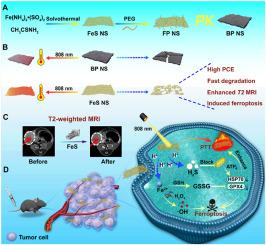Novel ultrathin ferrous sulfide nanosheets: Towards replacing black phosphorus in anticancer nanotheranostics
IF 18
1区 医学
Q1 ENGINEERING, BIOMEDICAL
引用次数: 0
Abstract
Biodegradable two-dimensional nanomaterials could be a significant breakthrough in the field of oncology nanotheranostic agents, which are rapidly emerging as promising candidates for tumor theranostic applications. Herein, a novel biodegradable ferrous sulfide nanosheet (FeS NS) is developed. Compared to the traditional photothermal material, black phosphorus nanosheet (BP NS), FeS demonstrates superior degradability and enhanced photothermal performance, and making it ideal for efficient photothermal therapy (PTT) of tumors. In the acidic tumor microenvironment, FeS degrades and releases H2S, which inhibits mitochondrial respiration and ATP production. This process leads to a reduction in heat shock protein expression, lowering the resistance of tumor cells to photothermal stimulation, and improving the efficacy of PTT. The released Fe2+ exhibits efficient peroxidase activity, triggering ferroptosis in tumor cells. Furthermore, due to its superparamagnetic nature, FeS NSs could accumulate at the tumor site and provide a strong magnetic resonance imaging (MRI) signal for imaging-guided tumor therapy. Overall, as a promising alternative to BP, the FeS NSs are a potentially innovative nanotheranostic agent of tumors, offering a synergistic approach to ferroptosis−PTT with MRI guidance.

新型超薄硫化亚铁纳米片:在抗癌纳米otheranostics中取代黑磷
可生物降解的二维纳米材料可能是肿瘤纳米治疗剂领域的一个重大突破,它正迅速成为肿瘤治疗应用的有前途的候选材料。本文开发了一种新型可生物降解硫化亚铁纳米片(FeS NS)。与传统的光热材料黑磷纳米片(BP NS)相比,硫化亚铁具有更优越的可降解性和更强的光热性能,是肿瘤高效光热疗法(PTT)的理想选择。在酸性肿瘤微环境中,FeS 会降解并释放出 H2S,从而抑制线粒体呼吸和 ATP 的产生。这一过程会减少热休克蛋白的表达,降低肿瘤细胞对光热刺激的抵抗力,提高 PTT 的疗效。释放出的 Fe2+ 具有高效的过氧化物酶活性,可引发肿瘤细胞的铁变态反应。此外,由于具有超顺磁性,FeS NSs 可以在肿瘤部位聚集,为成像引导的肿瘤治疗提供强大的磁共振成像(MRI)信号。总之,作为 BP 的一种有前途的替代品,FeS NSs 是一种潜在的创新性肿瘤纳米otheranostic 药剂,提供了一种具有磁共振成像引导的铁卟啉-PTT 协同方法。
本文章由计算机程序翻译,如有差异,请以英文原文为准。
求助全文
约1分钟内获得全文
求助全文
来源期刊

Bioactive Materials
Biochemistry, Genetics and Molecular Biology-Biotechnology
CiteScore
28.00
自引率
6.30%
发文量
436
审稿时长
20 days
期刊介绍:
Bioactive Materials is a peer-reviewed research publication that focuses on advancements in bioactive materials. The journal accepts research papers, reviews, and rapid communications in the field of next-generation biomaterials that interact with cells, tissues, and organs in various living organisms.
The primary goal of Bioactive Materials is to promote the science and engineering of biomaterials that exhibit adaptiveness to the biological environment. These materials are specifically designed to stimulate or direct appropriate cell and tissue responses or regulate interactions with microorganisms.
The journal covers a wide range of bioactive materials, including those that are engineered or designed in terms of their physical form (e.g. particulate, fiber), topology (e.g. porosity, surface roughness), or dimensions (ranging from macro to nano-scales). Contributions are sought from the following categories of bioactive materials:
Bioactive metals and alloys
Bioactive inorganics: ceramics, glasses, and carbon-based materials
Bioactive polymers and gels
Bioactive materials derived from natural sources
Bioactive composites
These materials find applications in human and veterinary medicine, such as implants, tissue engineering scaffolds, cell/drug/gene carriers, as well as imaging and sensing devices.
 求助内容:
求助内容: 应助结果提醒方式:
应助结果提醒方式:


